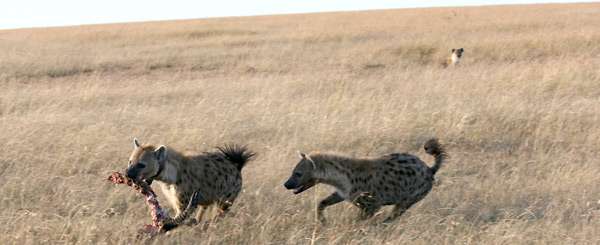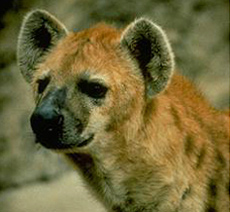Giggles give clues to hyena's social status
While dominant hyenas have a steady, confident-sounding giggle, subordinate ones produce a more variable call, allowing the animals to keep track of their social hierarchy, according to a new University of California, Berkeley, study.
In the first analysis of the giggle call of the spotted, or "laughing," hyena, UC Berkeley researchers show that these calls convey not only information about social status, but also about the age — the pitch goes down as the hyena gets older — and identity of each individual animal.

Among hyenas, however, where hypermasculinized females dominate males and there is a strict hierarchy among all animals of a clan, the key message conveyed by the variety of giggles produced by different animals and in different behavioral contexts may well be social stature.
"The giggles of Kombo and Kadogo, two dominant animals, are more steady: he – he – he – he. Whereas those of Winnie and Ursa, two subordinate animals, are more variable: he hi – ha – he," said Frédéric E. Theunissen, UC Berkeley professor of psychology.

"Giggles are a series of short staccato outbursts they make when they are not getting what they want," he said. "In the vocalizations of subordinate animals, there is a level of frustration or stress that comes through in the variability of the giggles, whereas the dominant animals have a more steady and confident giggle. This information could be used by other hyenas in the clan to assess whether or not to collaborate with the animal producing the calls. It could also send a submissive signal to a dominant animal that is the object of the conflict."
The findings were published Tuesday, March 30, in the open-access journal BMC Ecology.
Theunissen discovered the hidden meaning of hyena giggling by recording hyena vocalizations during feeding time at UC Berkeley's 26-member-strong colony and then analyzing the changing pitch on the recordings. Using similar techniques, he has also studied vocalizations in the zebra finch.
"Each animal has a different voice quality that makes it identifiable even when you hear only one note of its giggle," he said.
He hopes to do further studies in the wild, though this can be difficult because the giggles are taken up by other members of the group, making it hard to determine who giggled what.
"It's fascinating working with these animals, and not only because of their unusual social interactions," Theunissen said. "They are just unique, loud, amazing animals."
The work was conducted at the UC Berkeley hyena colony by Theunissen and Nicolas Mathevon, a former Visiting Miller Professor at UC Berkeley who is now at the Université de Saint-Etienne, France. Their colleagues included Aaron Koralek of UC Berkeley's Wills Neuroscience Institute; Mary Weldele of the campus's departments of psychology and of integrative biology; and Stephen E. Glickman, UC Berkeley professor of psychology and of integrative biology.
The work was funded by the National Science Foundation and UC Berkeley's Miller Institute.
